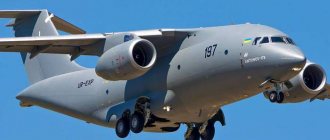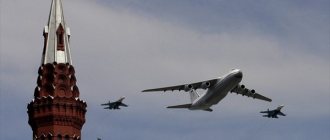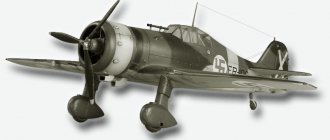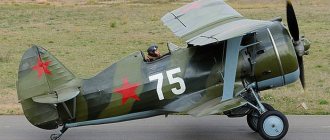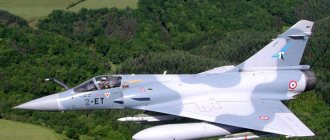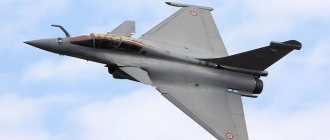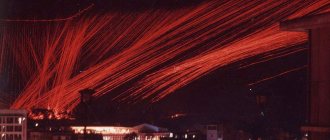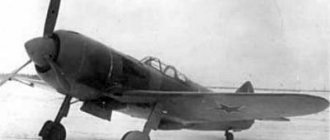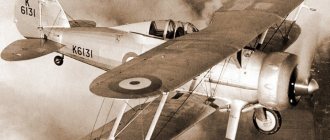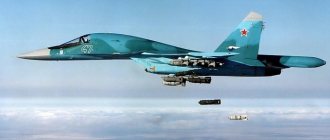Tu-95 (product “B”, according to NATO codification: Bear - “Bear”) is a Soviet/Russian turboprop strategic missile-carrying bomber, one of the fastest propeller-driven aircraft, which became one of the symbols of the Cold War.
The world's last adopted and mass-produced turboprop bomber. It had many modifications in accordance with current tasks. The latest modification is designed to destroy important targets behind enemy lines with cruise missiles at any time of the day and in any weather conditions.
Along with the American B-52 strategic bomber, the Tu-95 is one of the few military aircraft that have been in continuous service for more than half a century.
Armament
The bomb load of Tu-95 aircraft can reach 12,000 kg.
Free-falling (including nuclear) aircraft bombs with a caliber of up to 9000 kg can be placed in the fuselage bomb bay. Tu-95KD and Tu-95-20 were armed with Kh-20 cruise missiles with a nuclear warhead, designed to destroy radio-contrast targets at distances of 300-600 km.
The Tu-95V (existed in a single copy) was converted for use as a delivery vehicle for the world's most powerful thermonuclear bomb. The weight of this bomb was 26.5 tons, and the power in TNT equivalent was 50 megatons. After testing the Tsar Bomb on October 30, 1961, this aircraft was no longer used for its intended purpose.
The Tu-95MS, which forms the backbone of Russia's strategic aviation, carries Kh-55 cruise missiles. In the Tu-95MS6 modification, six such missiles are placed in the cargo compartment on a multi-position drum-type launcher. In the modification of the Tu-95MS16, in addition to the intra-fuselage launcher, ten more X-55 missiles are suspended on four underwing mounts (but this is prohibited by international agreements). The equipment for free-falling ammunition has been removed from the aircraft.
The defensive armament of Tu-95 aircraft consists of 23 mm aircraft cannons. On older modifications of the aircraft, six twin AM-23 cannons are installed in three defensive rifle installations (upper, lower and aft), and only two AM-23 or GSh-23 cannons on the Tu-95MS in the stern.
Aft mount with AM-23 cannons (note the thickness of the cockpit glazing)
Some Tu-95MS aircraft are named after cities.
Airborne radar
Cockpit
And another photo...
Tu-95. From the history of the “Russian Bear”
The first attempt to create an intercontinental bomber in the USSR was a deep modernization of the Tu-4. Airplane 80 (its first flight took place on December 1, 1949) covered a distance of 8,000 km. However, the Korean War, which began soon after, convincingly showed the futility of developing long-range bombers based on piston engines: jet fighters left it less and less chance of breaking through to protected objects. That is why, despite the possibility of achieving a range of more than 12,000 km, further work on the next Soviet strategic bomber, the Tu-85, was stopped. As a new model of such a machine, it was planned to create a bomber with a maximum speed of about 900-950 km/h, a payload capacity of up to 20 tons, a flight range of up to 14-15 thousand km and a flight altitude of 13-14 thousand m.
To meet such high requirements, it was necessary to apply a new aerodynamic design and use not only a powerful, but also a lightweight power plant, which also had acceptable fuel consumption. There was practically no other opportunity to achieve intercontinental range with all other parameters. Based on TsAGI developments on the aerodynamics of a swept wing and optimization of its design, the A. Tupolev Design Bureau selected the aerodynamic design of a multi-engine aircraft with a 35° swept wing. The layout of its fuselage, crew accommodation, weapons systems and target equipment developed the ideas embodied in the Tu-85, but the presence of a swept wing made it possible to place a large bomb bay behind the wing center section box, which was located near the center of gravity of the aircraft.
The most difficult task was the choice of the power plant and the option for its placement on the aircraft. According to calculations carried out by the design bureau, it was impossible to obtain the required flight performance characteristics, especially for the maximum flight range, using turbojet engines, which the customer insisted on. What the Tupolev Design Bureau “had” at that time was the AM-3 turbojet engine with a thrust of 8700 kgf and the AL-5 with a thrust of 5000 kgf. True, by the end of the forties, OKB V Klimov created a prototype VK-2 turboprop engine with a power of 4820 hp, with a low specific fuel consumption of 326 g/hp. and a specific gravity of 290 g/hp, but the development of this engine has so far been limited to bench tests.
At the same time, the N. Kuznetsov Design Bureau, relying on the work of interned German specialists, presented the TV-2 turboprop engine with a power of 6260 hp for testing. and completed the design of the TV-12 with a fantastic power of 12,000 hp at that time.
The Tupolev Design Bureau carefully studied aircraft options with almost all promising aircraft engines developed in the USSR: turbojet engines, turbojet engines in combination with piston engines, in combination with turboprop engines. Various power plant layouts were studied. In particular, a preliminary design was completed on the topic, in which six AM-3 type turbojet engines were located on both sides of the fuselage, in pairs, one above the other, and two more engines were located in the fuselage below, behind the wing. All this looked very exotic, but even according to the first estimates, it did not allow us to achieve the specified performance characteristics.
As a result, it was concluded that four theater engines with a total power of at least 40,000 hp correspond to the greatest extent to the required aircraft.
The new aircraft received the code “95” at the OKB. The head of work on the topic was N. Bazenkov, later the chief designer of all the numerous variants of the Tu-95 family. In 1976, after his death, N. Kirsanov became the chief designer for all aircraft of the Tu-95 series.
According to the decree on the creation of "95", issued on July 11, 1951, the aircraft was required to be manufactured in two copies. The first with twin TV-2 motors (2TV-2F) and the second with TV-12. The power in both versions was about 12,000 hp. for each engine.
The take-off weight of the new aircraft was determined to be 150 tons, so it was necessary to scrupulously approach issues related to the structural strength of the bomber. First of all, this applied to the swept wing, which had a large span and aspect ratio, and had high aerodynamic properties. The presence of four unusually powerful motors with propellers on the wing required the search for new design solutions to ensure its vibration resistance. At the same time, Tupolev paid special attention to compliance with the conditions for every possible compaction of the layout.
The solution to the complex problem fell to the K. Zhdanov Design Bureau, which developed a gearbox and coaxial four-blade propellers with the opposite direction of rotation. There were no analogues in world aviation practice in those years. As a result, the Tu-95 was equipped with a unique planetary gearbox and propeller with unusually high efficiency in all modes, which remain unsurpassed to this day. In September 1951, the OKB began producing working drawings; in the same month, production of the first copy began, and a year later the first prototype was ready. The objectives of testing this aircraft were to test in the shortest possible time the correctness of the chosen concept of a strategic intercontinental bomber, and to test all its systems and equipment in real conditions. The “95/1” was a purely experimental vehicle, preparing the way for the “95/2” with the TV-12 theater. The “95/1” took flight with a crew led by test pilot A. Perelet on November 12, 1952. The car was in the air for 50 minutes.
All winter and spring of the following year he was tested. On the seventeenth flight, an accident occurred: the third engine caught fire. Despite all the attempts of the crew, the fire could not be extinguished, and A. Perelet gave the command to abandon the plane. On board, without stopping attempts to save the car, only he and flight engineer A. Chernov remained. When leaving the plane, navigator Kirichenko and NISO engineer Bolshakov died, the rest of the crew remained alive.
During the investigation, it was established that the fire occurred as a result of the destruction of the intermediate gear of the third 2TV-2F engine gearbox due to its insufficient strength and was not extinguished due to the insufficient effectiveness of aircraft fire extinguishing equipment.
The disaster was deeply felt by the entire design bureau team, but the second prototype was already under construction, and the task was to take into account all the identified shortcomings and omissions in it, and to use the experience of fine-tuning the first Tu-16.
In July 1954, the 95/2 aircraft was manufactured and until December of the same year stood waiting for TV-12 engines, which were brought to condition. At the Design Bureau of K. Zhdanov and N. Kuznetsov, each unit was checked with special care.
In January 1955, the “backup” was taken to an experimental airfield, and on February 16, the crew led by test pilot M. Nyukhtikov (2nd pilot I. Sukhomlin) made the first takeoff on “95/2”. Its factory tests were completed at the beginning of 1956. By this time, aircraft production was already underway at Kuibyshev plant No. 18. The first two production 95 aircraft took off in October 1955, after which state tests were carried out on three aircraft.
At the same time, the following results were obtained for the “95/2” aircraft: maximum speed - 882 km/h, flight range with a bomb load of 5 tons - 15,040 km, ceiling - 11,300 m. In terms of speed and ceiling, the data did not meet the customer’s requirements, therefore New engines were installed on the second production vehicle (NK-12M instead of NK-12), which already had a take-off power of 15,000 e. l. With. and lower fuel consumption. The aircraft had increased fuel capacity and take-off weight. In September-October 1957, it reached a maximum speed of 905 km/h, a ceiling of 12,150 m, and a range of 16,750 km.
The bomber was accepted for mass production and produced since 1955 in two modifications: Tu-95 and Tu-95M. Soon the first of them began to receive combat units. It was adopted into service in August 1957 and became the main Soviet strategic deterrent at the height of the Cold War until the first ballistic intercontinental missiles were adopted in the sixties.
The Tu-95 and Tu-95M were in serial production until 1959; Several aircraft were produced in the Tu-95MR strategic reconnaissance version. Two cars were converted into passenger cars and used for special transportation. On these aircraft, the bomb bay housed a pressurized cabin for 20-24 people. They were called Tu-116 and were used by the Air Force until the end of the eighties.
Tu-95 bombers were designed to carry out bombing attacks, including nuclear weapons, on strategic targets located deep behind enemy lines. At the time of its creation, it was believed that the combination of high flight speed, altitude and powerful defensive weapons made strategic aircraft practically invulnerable to the then air defense systems. Small arms and cannon weapons (6 23 mm caliber guns) made it possible to provide almost spherical protection from enemy fighter aircraft. The stern installation was equipped with an Argon radar gun sight. The bomb load of the Tu-95 varied from 5 to 15 tons depending on the flight range. The maximum caliber of bombs placed on the internal sling was 9 tons.
The Tu-95 equipment was equipped with the most modern systems of that period, which made it possible to perform flights in difficult weather conditions.
On the first Tu-95, the crew included eight people: two pilots, a navigator, a flight engineer, a navigator-operator, a gunner-radio operator (in the front pressurized cabin) and two gunners in the aft cabin. A feature of the escape system on the Tu-95, unlike other jet bombers of that time, was the absence of ejection seats.
From the front cabin, in an emergency, the crew left the bomber through the open hatch of the nose landing gear using a movable conveyor, and the rear gunners were thrown down through the hatches.
In March 1957, the Tu-95 crashed. The failure of one engine should not have led to a catastrophic situation, but on this flight the system for moving the propellers to the feathering position did not work. Very promptly, a few months later, NK-12MV engines with automatic and manual feathering were put into production.
Strengthening the potential enemy's air defense systems required the aircraft's developers to improve its performance characteristics. Back in 1952, an order was issued to build a high-altitude strategic bomber with a flight ceiling over a target of 17 thousand meters and a flight range at that altitude of up to 9000-10000 km, with a combat load of 5 tons and a speed of 800-850 km/h. It was supposed to install new NK-16 engines, high-altitude and more powerful. The car was named Tu-96. It had slightly larger dimensions, a new fuselage, bow cockpit and center section design. In 1956, the aircraft entered factory testing. But by this time it had already become clear that the high flight altitude would not save the bomber from attacks by supersonic interceptor fighters and anti-aircraft missiles. Work on the Tu-96 was stopped.
The main direction in increasing the efficiency of strike aviation forces in the mid and second half of the fifties was the creation of aircraft-missile systems that used the long range of the carriers and the invulnerability of the projectile aircraft launched from the carrier several hundred or thousand kilometers from the target. This combined option was supposed to increase the survivability of the strike system.
The aviation and missile system, named Tu-95K-20, began to be developed in March 1955. The carrier aircraft underwent alterations: a new nose section was designed, where radars were installed to detect the target and point the projectile aircraft at it. The A. Mikoyan Design Bureau created the X-20 projectile aircraft for the complex with a range of 350 km and a flight speed corresponding to 2M. The X-20 was located in the bomb bay on a special holder, which raised the projectile up before flight and lowered it before launch.
The carrier prototype, Tu-95K, was lifted into the air on January 1, 1956. Finishing work on the complex has begun. To test the X-20 systems, OKB specialists converted a serial MiG-19 (SM-20 aircraft), on which the guidance system, suspension and release from the carrier aircraft were tested in a manned version.
Due to the novelty of the subject, testing and fine-tuning of the complex were delayed, and only in September 1959 the Tu-95K-20 was officially accepted into service. As a result of modifications to the Tu-95, its aerodynamics deteriorated, resulting in a decrease in flight range. Air refueling could have saved the situation. In the spring of 1960, the A. Tupolev Design Bureau was tasked with developing a “hose-cone” refueling system for the Tu-95K. A year later, the first Tu-95K was equipped with such a system and received the name Tu-95KD. Both options. “K” and “KD” were mass-produced until 1965, which significantly increased the combat capabilities of domestic strategic aviation.
In the sixties, some of the K series aircraft had their radio and navigation equipment updated, after which the aircraft received the Tu-95KM designation. At the beginning of the next decade, it was decided to convert the Tu-95K and Tu-95KD into carriers of air-to-ground guided missiles, similar to those used on the Tu-22 and Tu-22M supersonic bombers. The new complex, Tu-95K-22, included one or two missiles, suspended on underwing pylons or in the cargo bay.
The prototype Tu-95K-22, developed on the basis of the serial Tu-95K, first took off from the runway in October 1975. After testing was completed in the late seventies, modifications to the Tu-95K-22 fleet of Tu-95K aircraft began. Since the beginning of the eighties, the vehicles entered combat units in a new quality.
As you know, in the first half of the sixties, the USSR Navy began to enter the ocean. Its submarine and surface forces required a means of long-range reconnaissance and target designation. Already in 1962, the Tu-95RTs entered testing. For two years, the entire complex of radar and radio engineering systems of the new vehicle was refined and brought up to standard, and in 1964 its deliveries to the Navy aviation began.
A special place among the Tu-95 modifications is occupied by the Tu-126 early warning aircraft, equipped with the Liana radar complex. Work on it began back in 1960. The first prototype was ready two years later. In 1965-1967, eight more Tu-126s were produced. All nine aircraft were in service until the early eighties, when they were replaced by the more advanced A-50.
One of the most important components of the American nuclear “triad” since the sixties has been a combination of nuclear submarines equipped with submarine-launched ballistic missiles. To combat them, the USSR in 1963 began developing a long-range anti-submarine strike system based on the Tu-95, capable of detecting and destroying submarines on the surface and underwater. In the summer of 1968, the experimental Tu-142 made its first takeoff. It differed from the Tu-95 in its target equipment, a new wing design and a reduced number of small arms and cannon weapons. Initially, the Tu-142 had original main landing gear bogies with six wheels, which ensured the possibility of using unpaved runways. Tu-142 aircraft entered service with the Navy aviation in December 1972.
In the seventies, the combat capabilities of nuclear missile submarines increased significantly, which required the modernization of anti-submarine weapons, including aircraft anti-submarine systems. At the OKB named after A.N. Tupolev, under the general leadership of general designer A. Tupolev, in 1972 initiated work on modernizing the Tu-142. As a result, they created the Tu-142M aircraft, which was equipped with equipment for detecting low-noise submarines, a more accurate inertial navigation system, an updated automated radio communication system, a Ladoga magnetometer, and the front cockpit was completely changed. The first flight of the Tu-142M was made by test pilot I. Vedernikov on November 4, 1975. Since 1980, this machine has been successfully operated in parts. Based on the Tu-142M, the Tu-142MR repeater aircraft was subsequently developed for the needs of the submarine fleet.
Work in the United States to modernize strategic strike aircraft systems based on the B-52 and arm them with cruise missiles caused a response from the Soviet side. The start of work on re-equipping the Tu-95 fleet with new missiles can be dated back to the early seventies, when the Tu-95M-5 (Tu-E5K-26 complex) was produced on a trial basis, armed with two KSR-5 missiles used on the Tu-16K -26. However, this direction has not received development.
In 1976, also on a trial basis, one of the production copies of the Tu-95M was converted into a missile carrier with air-launched cruise missiles - the Tu-95M-55. In 1978, it passed factory tests, but this time there was no decision to convert the fleet aircraft.
At the same time, based on the Tu-142M, work was carried out on a strategic carrier of cruise missiles. The new version, called the Tu-95MS, made its first flight in September 1979, and in the early eighties entered service, and to this day is in service with the strategic aviation of the Russian Armed Forces.
Tu-95MS has very high defensive capabilities. The crews assessed the plane as literally unbreakable. The airborne defense system (ADS) of this vehicle has become the most advanced in our country and has surpassed the complex of the American B-52N in many respects. At "EMES" it was possible to successfully resolve the problems of electromagnetic compatibility, which spoiled so much blood during the creation of the Tu-160. In the summer of 1987, during specially conducted tests, its electronics managed to brilliantly thwart all attempts to carry out attacks on the most modern and electronically equipped MiG-31 interceptor. The flight took place at night in simple weather conditions at an altitude of 8000 m. The crew of the thirty-first reported: “I am observing the target visually, I can work with a cannon, it is impossible to carry out a tactical launch.” It is worth noting that the characteristics of the MiG-31 airborne system were significantly superior to those of the American F-15. As you can see, by the end of the last century, the stern gun again returned to its previous meaning.
Combat duty was again organized on these vehicles. At the same time, its crews were no longer subject to the same psychological stress that their predecessors who flew bombers experienced. They did not need to enter the range of powerful air defense, and besides, they did not know their targets, or even the launch point. The crew’s task was to bring the attack vehicle to a certain point, from where it would automatically fly for another hour, after which it would also independently launch missiles.
One of the most famous modifications of the Tu-95 bomber was its passenger version - the Tu-114. Work at the Design Bureau on this aircraft began in 1955. The prototype was lifted into the sky by test pilot A. Yakimov, November 10, 1957. State tests ended in July 1960, and operational tests ended in March of the following year.
On April 24, 1961, the first flight of the Tu-114 with passengers on board took place, traveling from Moscow to Khabarovsk. In total, until 1965, 31 Tu-114s were built at the Kuibyshev aircraft plant, which successfully served on domestic and international routes until 1980. During this period, more than 6 million passengers were transported. The airliner was produced in configurations for 170 and 200 seats. And in 1962, an option was prepared for flights to Cuba: the number of passenger seats was reduced to 120 due to an increase in fuel reserves. Since January 1963, regular flights to Havana began, with one stopover.
The Tu-114 set 32 world records. In addition, in 1958, the airliner was awarded the “Grand Prix” at the Brussels International Exhibition, and A.N. Tupolev was awarded the FAI Grand Gold Medal. Various flying laboratories were also created, where promising aircraft engines, equipment and aircraft systems were tested. There were many unfulfilled projects of carrier aircraft for various types of manned and unmanned objects. The Tu-95, the only aircraft of its class with a theater of operations in the world, has gone through a glorious and difficult path, from its birth to the present day.
Sources: Rigmant V. Tu-95 // Aviation and Cosmonautics. 2001. No. 1. pp. 17-26. Rigmant V. Tu-95 // Aviation and Cosmonautics. 2000. No. 12. pp. 8-14. Kirsanov N. Rigmant V. Having no analogues // Aviation and Cosmonautics. 1992. No. 12. pp. 14-17. Gordon E. Rigmant V. Tu-95. The goal is America // Aviation and time. 1996. No. 5. P.2-20. Antonov D. Rigmant V. From the dossier of the “Russian Bear” // Wings of the Motherland. 1994. No. 6. pp. 8-10. Antonov D. Rigmant V. From the dossier of the “Russian Bear” // Wings of the Motherland. 1994. No. 7. pp. 1-5.
The main disadvantages of the bomber
The key feature of the TU-95MS engines was their high power, but these engines also had their drawbacks. For example, the oil used was mineral-based and was not intended for operation at low temperatures. So, when the mark on the thermometer was below 0, the screws became staked, therefore, starting the unit was impossible.
To solve this problem, various types of heat guns and heat-insulating covers were used. To prevent the oil from freezing, the engines were started every two hours. After some time, MH-7.5U oil was developed with a freezing point of -25 degrees Celsius.
It is practically impossible to replace the NK-12 engine with a more modern one, since this requires a huge number of alterations, as well as highly qualified personnel. After all, it's not financially viable.
As the diagram above the TU-95MS makes it possible to understand, placing the crew in a pressurized cabin also had its drawbacks. In particular, dryness and oily dust in the air, uncomfortable seats and toilets. All this led to premature fatigue of the crew during long flights. Also, as noted above, there were and are no devices on the plane for ejection during the fall.
About the design in detail
The most interesting is the structural part of the aircraft, since it is here that the brilliant engineering thought of the designers of that time is clearly visible. TU-95MS had an all-metal body and swept wings, which housed 4 screw (turbocharged) engines
It is worth paying attention to the all-electric heating of the wing tips, stabilizer and fin
The chassis was also carefully worked out. It had a three-post design, which was the most effective, although not the easiest or cheapest to manufacture. Thus, the front pillar was not equipped with brakes and had one wheel. The main struts were equipped with wheels with brakes and were retracted into the gondolas, and the front one into the fuselage.
Airplane for the Tsar Bomba
In October 1961, the Soviet Union tested the world's most powerful thermonuclear bomb. A special aircraft, the Tu-95B, was designed to drop ammunition weighing 26 tons onto Novaya Zemlya. Since the Tsar Bomba did not fit in the weapons bay, the bomb bay covers were removed, all electrical connectors were replaced, and the fuselage was painted with white reflective paint. At the moment of the explosion of the Tsar Bomba, its carrier was 39 kilometers from the epicenter at an altitude of 11,500 meters. The electromagnetic pulse stopped three of the bomber's four engines. The crew commander, Andrei Durnovtsev, put the plane into a dive and started the engines on the move: the second at 7,000 meters, the third at 5,000. The fourth did not start - after landing it turned out that he was badly burned. The paint on the fuselage was also charred here and there. Durnovtsev flew to Novaya Zemlya as a major, and returned as a lieutenant colonel; six months later he became a Hero of the Soviet Union.
Valuable gift: 50 years ago, a secret US drone flew to the USSR
Based on the Tu-95, carriers of the Spiral orbital aircraft and the supersonic cruise missile X-20, a flying laboratory for the nuclear aircraft program and a naval reconnaissance target designator, the passenger Tu-114 and the submarine hunter Tu-142 were created. Unlike Tu-160, which are named after famous pilots, personalized Tu-95 are named after Russian cities. The bomber with tail number 12 is called “Moskva”, the naval reconnaissance aircraft number 53 is called “Vanino”.
Battle of the constructors
In the late 40s, the United States had a fleet of strategic bombers to deliver atomic bombs to the territory of the Soviet Union. B-29s and B-36s were on duty at military bases surrounding the USSR on the perimeter. There was nothing to oppose them - the most powerful Soviet bomber Tu-4 could not fly to America. Andrei Tupolev was summoned to the Kremlin and offered to create a heavy intercontinental-range jet aircraft as soon as possible. At the same time, Vladimir Myasishchev was assigned the same task. Stalin calculated correctly: spurred on by competition, Tupolev built a fundamentally new aircraft with a swept wing in two years. At the same time, the designer insisted on his own - his bomber was a turboprop, since jet engines of that time consumed a lot of fuel
The world's most powerful engine, the NK-12, was designed for the Tu-95. Its turbine efficiency of 34 percent still remains a record. To prevent 15 thousand horsepower from tearing apart the propeller, it had to be made seven meters long, which was not suitable for layout reasons. Therefore, each of the four bomber engines rotates two coaxial propellers with unique performance - their creator was awarded the Lenin Prize. The enormous power of the engines and the design of the propellers made the Tu-95 one of the noisiest aircraft in the world, which did not in any way affect its combat qualities. The bomber's main weapon is long-range strategic cruise missiles. They can be launched without approaching the enemy air defense coverage area - for example, from the North Pole, where Tu-95s were on duty during the Cold War.
Modifications of TU-95
From 1956 to 1960, a large number of modifications of the bomber were produced. The most famous of them:
- TU-95A and TU-95MA (used as nuclear bombers);
- TU-95M;
- TU-95K (missile carrier);
It is also worth noting that this strategic bomber served as the basis for the development of such famous aircraft as the TU-142 (used to fight enemy ships) and TU-114 (used as a passenger airliner).
In the mid-60s, the TU-95K was stopped produced, and the same TU-95MS was developed on the basis of the TU-142. This bomber was produced until 1992. In total, about 90 aircraft were assembled, which gradually replaced outdated modifications.
The main tasks of the Tu-95 aircraft
During war, strategic bombers are used to deliver powerful strikes against the most important and significant targets. The Soviet (Russian) Tu-95 aircraft is designed to solve the same problems. It is considered primarily as a means of delivering nuclear weapons for the destruction of various objects on the territory of the United States and its NATO allies.
At first, atomic warheads were mounted on conventional free-falling bombs, but later preference was given to air-launched cruise missiles. The Tu-95MS armed with them are an effective deterrent, being part of the Russian nuclear “triad”.
In addition, these aircraft can solve other tasks, including:
- Reconnaissance and aerial photography;
- Search and destruction of enemy submarines (in the Tu-142 version);
- Detection and subsequent tracking of aircraft carrier strike groups;
- Fighting enemy surface ships.
Tu-95 bombers were involved in striking terrorists in Syria. In this case, Kh-555 and Kh-101 missiles with “conventional” warheads were used.
Tu-95MSM over Volgograd shortly before striking terrorists in Syria. Under the wing - two X-101 missiles on beam holders
Tu-95 design
The Tu-95MS strategic missile carrier-bomber is based on the Tu-142MK. By type of design, it is a cantilever all-metal mid-wing, which had four turboprop engines, which were placed in swept wings.
Each engine was composed of two coaxial metal four-blade propellers. The aircraft's design includes an electrical heating system for the stabilizer, wing tips, propellers and fin. The middle part of the fuselage is reserved for the cargo compartment.
The Tu-95MS aircraft has a tricycle landing gear. The front support is equipped with two non-braking wheels, the main supports are equipped with four brake wheels.
The nose strut retracts into the fuselage niche, the main ones into the wing nacelles. The hydraulic system or, in an emergency, a pneumatic system is responsible for releasing and retracting the nose strut. The main landing gear supports are driven by MPSh-18MT electrical mechanisms, which include two engines with a total power of 5200 W.
To accommodate the crew members, two pressurized cabins were allocated, which were not equipped with ejection seats. In an emergency, the crew is required to exit the aircraft through the hatch of the lower landing gear, which is located under the front pressurized cabin. Evacuation from the rear pressurized cabin is carried out through the rear entrance hatch.
The bomber is equipped with the most powerful NK-12 turboprop engines in the world. They include a 14-stage compressor and a highly economical five-stage turbine. A system of air passage valves is responsible for regulating the compressor. The engine turbine has the highest efficiency among aircraft engines - 34%. This aircraft was the first to introduce a unified fuel supply regulation system, which was localized in a single unit.
Features of the motor, such as the design of the propellers and high power, generate a lot of noise during flight. The Tu-95 is considered one of the noisiest aircraft in the world, but this does not prevent it from being used as an ultra-long-range missile carrier-bomber.
The engine propellers are protected by a 115V AC electro-thermal de-icing system.
The Tu-95 fuel system includes 11 tanks, which are located in the wings and fuselage.
Despite the imperfect aerodynamic parameters of the design, the aircraft easily covered long distances due to the high efficiency of the power plant.
Tu-95 (Tu-20) - a strategic bomber was created in the design bureau of A. N. Tupolev in the early 1950s. In 1955, it was already shown publicly at the Tu-95 air parade (second name, working name, Tu-20).
The first flight of the aircraft took place on November 11, 1952, tests were carried out by pilot A.D. Perelet. Tu-95 is one of the best in the world. It was mass-produced in versions of a “pure” bomber, missile carrier, long-range reconnaissance aircraft, military transport aircraft, and fuel tanker. The combat duty of a bomber with nuclear weapons on board near the state borders of a potential enemy was a serious factor in ensuring peace on the planet. The Tu-95 aircraft remains in service in the 21st century.
Tu-95 photo
Power plant: four turboprop engines designed by N.D. Kuznetsov NK-12M, each with a power of 15,000 hp. With. The propellers are four-blade, two blades per engine, rotating in different directions.
Tu-95 cabin
Performance characteristics of the Tu-95:
- Wingspan, m 51
- Aircraft length, m 49
- Height, m 13
- Wing area, m2 310
- Wing sweep 35°
- Maximum flight speed, km/h 1000
- Travel speed, km/h 900
- Launch weight, kg 160,000
- Practical ceiling, m 17,000
- Flight range, km 15,000
Tu-95 scheme
Armament: cannons, bombs placed in bomb bays or externally under the fuselage, air-to-surface missiles
On the basis of the military aircraft, a civilian version was developed - the Tu-114. The power plant of both versions of the aircraft did not differ; the geometric dimensions had, accordingly, slight differences.
History of the development of the Tu-95 "Bear" strategic bomber
In 1949, the USSR created and tested a nuclear bomb, which put an end to the US “atomic monopoly”. Nevertheless, there was no need to talk about the parity of the military capabilities of the two main adversaries in the Cold War, since the Soviet Union did not yet have the necessary “delivery means” - neither aircraft nor missiles.
The longest-range bomber remained the Tu-4 - a copy of the famous American B-29 aircraft. Using specially prepared sites in the Arctic Ocean, the Tu-4 could theoretically reach the United States, however, this method was clearly ineffective.
Design Bureau A.N. Tupolev (OKB-156), starting in 1948, on its own initiative, began developing an aircraft model, which received the preliminary designation “85”.
Tu-85 is a piston-powered strategic bomber, the immediate predecessor of the Tu-95.
It was a four-engine all-metal bomber with a straight wing and piston engines, capable of flying up to 12,000 kilometers with a bomb load. The first such machine was demonstrated at the air parade in Tushino on May 12, 1951. Preparations were also made for mass production, however, it never began.
The reason for abandoning the 85 aircraft was the results of air battles in Korea. During this conflict, Soviet MiG-15 jet fighters repeatedly destroyed large B-29 formations, thereby proving that the age of military piston aircraft was over. Until recently omnipotent, it has exhausted all possibilities for improving key performance characteristics. At the same time, it was clear that the “85” aircraft would be no less vulnerable in enemy airspace than American bombers in the skies of Korea. Thus, Soviet strategic aviation needed faster aircraft, no longer equipped with piston engines, but with jet engines.
The first to create such an aircraft, capable of flying long distances at high speed, was the aircraft designer V.M. Myasishchev, who proposed the SDB bomber project, later known as the M4. Tupolev initially considered such undertakings unrealistic, since the first turbojet engines were too “gluttonous.” There were other serious problems, for example, flutter (destructive vibrations) of long swept wings occurred at subsonic speeds.
The first Soviet jet strategic bomber M4 (designer - Myasishchev). The flight range of this machine was insufficient
While talking with Stalin, Tupolev mentioned these important details, but the aircraft designer failed to convince the leader of the USSR. The backwardness of piston aircraft became too obvious and it was no longer possible to ignore it. As a result, OKB-156 received an official government assignment to create a high-speed bomber with four turboprop engines for the Air Force.
Previous developments on the “85” aircraft greatly helped Tupolev both in the creation of a new aircraft and in the subsequent establishment of its mass production. In November 1952, a prototype bomber, designated "95-1", flew for the first time. Over the next six months, 16 successful test flights were carried out, and on May 11, 1953, a disaster occurred, as a result of which four of the nine crew members died. The cause of the tragedy was not weather conditions, but a defect in the engine design, which caused the destruction of gears and a fire.
The crash of the 95-1 prototype significantly delayed the process of creating the aircraft. This was largely due to the complexity of fine-tuning the NK-12 engine. Only in February 1955 did the cycle of flight and technical tests continue. Even before its completion, serial production of bombers began, this time under the official name Tu-95.
One of the first production Tu-95M
Subsequently, the aircraft was modernized several times. Some of the modifications were intended for reconnaissance, others were created in the interests of the navy. The Tu-95MS (MSM) aircraft in use today are missile carriers capable of delivering strikes without entering enemy airspace.
Let's sum it up
As a conclusion, we can safely say that the TU-95MS “Bear”, the characteristics of which we have reviewed, is one of the most powerful and impressive aircraft of the 90s and even today. The advantages include high load capacity, high power and flight range
All this is extremely important for a bomber. Of course, each such machine has its own disadvantages, which we also discussed.
Most of the weaknesses were eliminated during testing, as well as during modifications to the unit. This applies to both the power plant and weapons. Now we can safely say that the TU-95MS (“Bear”), whose characteristics are surprising even now, caused mixed reactions from other countries in the 1990s. That is why the bomber is in service with the Russian Air Force and there is unlikely to be a replacement for it in the next few years. But with the development of the latest air defense systems, radars, and other equipment, aircraft such as the Bear have little chance of successfully conducting an operation. Although we can only hope that the TU-95 MS will not be used for its intended purpose. After some time, the long-range bomber will peacefully go to the military museum.
Carrier Hunter
There are absolutely fantastic episodes in the long and glorious history of the aircraft. In the 60s, a British Lightning fighter attempted to intercept a Tu-95 over the North Sea. However, the Briton maneuvered so unsuccessfully that he crashed without causing any harm to the intended victim. In the early 70s, three US Air Force F-4 Phantom II fighters were scrambled from an aircraft carrier over the Atlantic to intercept a Tu-95MR naval reconnaissance aircraft. While trying to fly over a Soviet plane, one of the F-4s crashed into its wing and fell into the sea. Our reconnaissance aircraft completed its combat mission and returned to its airfield.
One of the favorite pastimes of the Tu-95 crews was hunting for US aircraft carriers. Their coordinates were transmitted from the shore, 200 kilometers away the planes descended to 100 meters, approached the Americans unnoticed and roared over the flight deck, showing friendly gestures to the stunned Americans. This trick was repeated in 2008 in the Sea of Japan - the Bear, arriving from near Khabarovsk, passed twice at an altitude of 600 meters above the Nimitz aircraft carrier, simulating a bombing. American fighters scrambled to intercept him could not stop him.
